Lizard Pose: Boost Your Yoga Routine with Deep Hip Openers
Step into the transformative Lizard Pose to deepen your hip flexibility, increase its mobility, and energize your body for an invigorating yoga sequence daily.
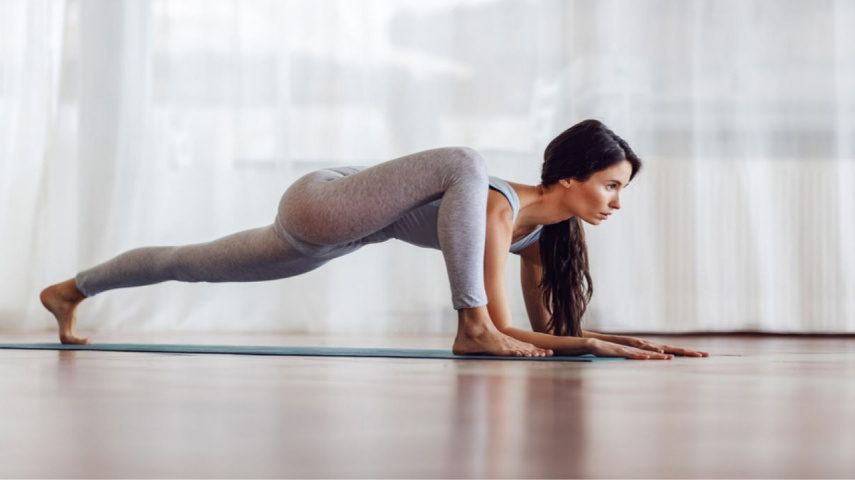
The transformative power of yoga lies in different poses that bring a cascade of benefits to both the body and mind. Lizard Pose, or Utthan Pristhasana, stands out as not just a posture but a gateway to enhanced flexibility and strength. Also known as Utthan Pristhasana in the traditional language of Sanskrit, this is a yoga asana that serves to expand and stretch the hip region. The term "Utthan" translates to an act of stretching or extending, "Pristha" refers metaphorically to a leaf or a page, indicative of the spreading nature of the pose, and "Asana" signifies a posture or position.
Speaking of the need of performing Lizard pose, our contributor Bayu Prihandito, who is a Life Coach, and RYT 200 Yoga Teacher, says, “Hip-opening poses are crucial for maintaining overall flexibility, reducing lower back pain, and improving posture, especially for those with sedentary lifestyles.”
Lizard Pose yoga is all about flexibility, mimicking the remarkable suppleness found in the reptile world. Through this asana, one can unlock the body's potential, fostering flexibility in the hips, shoulders, arms, and core. This powerful stretch, integrated within the flows of Vinyasa and the stillness of Yin Yoga, supports the connective tissues, enhancing the elasticity of the fascia and contributing to a more resilient and adaptable physique.
Yet, Lizard Pose is more than just a stretch. It's a foundation from which numerous variations emerge, each adding a new dimension to one's practice. This pose is a wellspring of energy, capable of rejuvenating the weary and bringing vitality to the stagnant. It caters to a broad spectrum of muscular focus — from the arms and shoulders down to the knees and quadriceps — making it a versatile element in any yoga routine. It also offers a host of mental benefits as it helps reduce stress, release tension, and focus on your well-being.
How to Do Lizard Pose: A Step-by-Step Guide
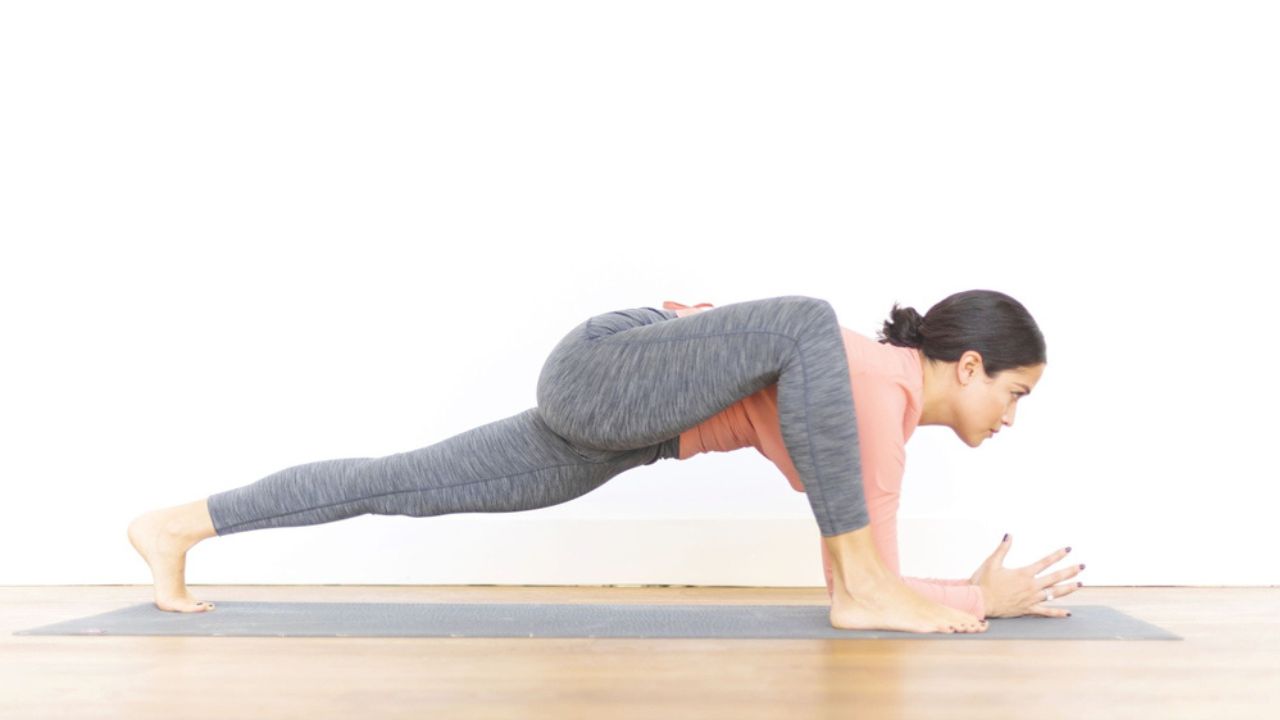
The Lizard Pose, known as Utthan Pristhasana in Sanskrit, stretches the hip flexors, hamstrings, and quadriceps. It prepares the practitioner for deeper asanas and develops flexibility in the lower body.
Step-by-Step Guide to Perform Lizard Pose
1. Begin by positioning yourself on all fours at the front of your mat.
2. Place your hands firmly on the mat under your shoulders, with your fingers pointing straight ahead.
3. Put your knees aligned under your hips.
4. Gradually shift your weight into your left leg and slide your right foot forward. Put it just outside of your right hand.
5. Align your right knee with your ankle, creating a 90-degree angle.
6. Carefully pivot on the right heel, turning the right toes outward at approximately 45 degrees to prepare for the deep hip stretch.
7. Straighten your back to lengthen your spine and tighten your core muscles to support your lower back.
8. Lower onto your forearms.
9. Bring your elbows directly under your shoulders. Keep your forearms parallel and hands spread in front of the elbows with the middle fingers pointing straight.
10. Press your palms and forearms into the mat, powering up the muscles in your arms and maintaining a stable base.
11. Bring your right knee snug against your right shoulder, activating your inner thigh muscles. This movement enhances the stretch in your right hamstring and gluteal muscles.
12. Lower your hips forward and down towards the mat to intensify the stretch across the front of your left hip and hip flexor.
13. Continue to keep your spine elongated and your core engaged, breathing steadily as you fix your gaze forward, holding the posture and feeling the stretch deepen with each exhale.
14. After holding the pose for the desired amount of time, gently release and repeat the sequence on the opposite side to ensure balance in the body.
The Lizard Yoga Pose challenges the body to relax into the intensity of the stretch while maintaining a strong core and engaged limbs. Regular practice leads to increased flexibility in the hips and thighs, a more stable core, and an overall sense of physical and mental balance.
8 Benefits of Lizard Pose That Go Beyond Stretching
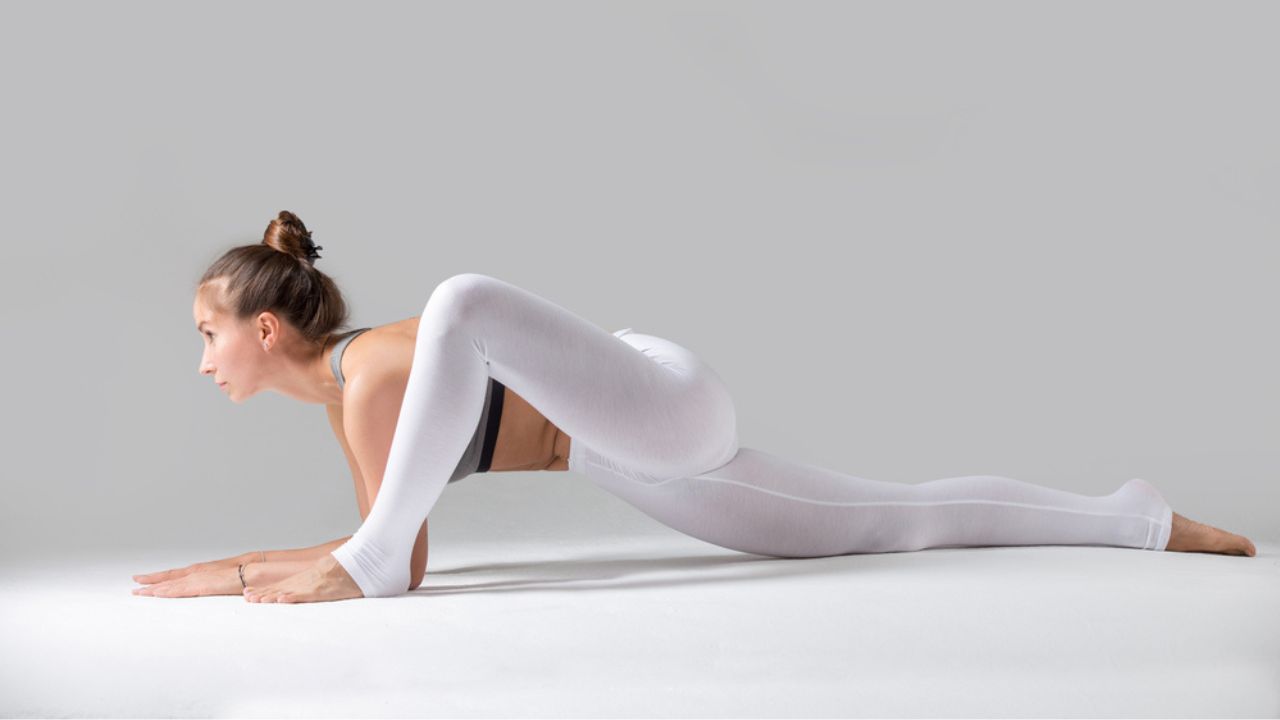
The benefits of Lizard Pose, or Utthan Pristhasana, extend beyond mere stretching, offering a wealth of positive outcomes. This comprehensive pose targets several areas of the body and offers improvements in muscle tone, flexibility, and overall well-being.
Let’s explore the diverse advantages of incorporating Lizard Pose into your yoga practice.
1. May Activate the Reproductive System
Lizard Pose provides a thorough stretch to the lower abdomen, particularly affecting the pelvic region. This action engages the pelvic floor muscles, which are crucial for reproductive organ support (1).
Consistent practice can lead to a balanced secretion of hormones, potentially easing symptoms associated with menopause and contributing to the overall health of the reproductive system (2).
2. May Tone the Gluteus Maximus Muscles
This is a powerful yoga asana to tone your muscles. This deep hip opener works on the hip muscles, specifically the gluteus maximus muscles (3). As these muscles are extended in the pose, they help maintain an upright posture and play a pivotal role in walking and running, thereby benefiting from the toning effect of the asana (3).
3. May Strengthen Shoulder Muscles
Engaging in Lizard Pose, an advanced yoga practice, may contract the deltoid muscles of the shoulders (4). You may have a more defined shape and enhanced strength, aiding in heavy lifting and preventing joint dislocations by stabilizing the shoulder blades (4).
4. May Enhance Physical and Inner Balance
While balancing on the forearms, Lizard Pose may encourage a deep focus on maintaining physical stability, which can translate into a heightened sense of inner balance (5). This awareness can ripple outwards, influencing overall life balance and inner peace (5).
5. May Improve Hip Flexibility
As a foundational pose, Lizard Pose creates space in the hips, promoting flexibility and setting the stage for more advanced postures (6). The hip opening stance also prepares the body for asanas that require a greater range of motion, such as the Pigeon Pose.
6. May Strengthen Hamstring and Quadricep Muscles
The legs may gain significant strength from Lizard Pose in yoga, particularly the hamstrings and quadriceps (7). This stretching not only tones the thighs but also primes the legs for more demanding postures, enhancing endurance and muscle resilience (7).
7. May Tone the Chest and Shoulders
The unique position of Lizard Pose may also tighten the muscles of the chest and shoulders, contributing to an overall strengthening of the upper body and helping improve your posture (8).
Athletes find Lizard Pose especially useful as it tones and strengthens the leg muscles, vital for sports such as soccer and running (9). The strengthening of the shoulders and chest also proves advantageous for sports like swimming.
8. May Reduce Excess Fat
Regular practice of Lizard Pose may lead to a more toned physique by reducing excess fat around the belly and hips, leading to tighter and more defined muscles in these areas (10).
Lizard Pose is a powerful tool for holistic physical development. Whether you are seeking to enhance your reproductive health, tone your muscles, or find a deeper sense of balance and flexibility, Utthan Pristhasana serves as a comprehensive asana with manifold benefits. From athletes to yoga enthusiasts, Lizard Pose benefits the body, mind, and spirit alike.
Variations And Modifications of Lizard Pose
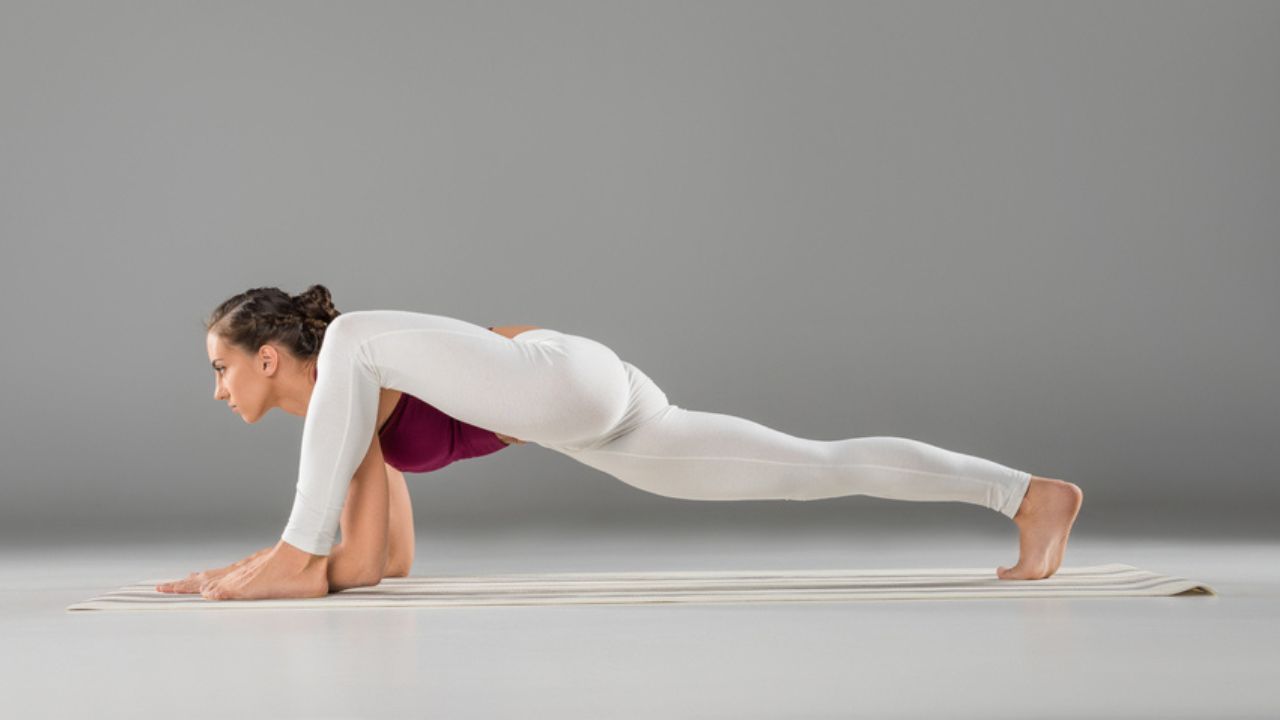
Lizard Pose, known for its hip-opening benefits, has variations that can enhance flexibility, strength, and awareness. Let's explore some of these variations and modifications to cater to different levels of yoga practitioners.
Parivrtta Utthan Pristhasana (Twisted Lizard Pose):
View this post on InstagramAdvertisement
This variant adds a revolved aspect to the traditional Lizard Pose, deepening the stretch and engaging the core with a twist.
Steps to Twisted Lizard Pose:
1. Begin in the standard Lizard Pose with your right foot forward.
2. Place your left hand on the mat directly under your shoulder and twist your right upper body towards the right thigh.
3. Reach your right hand towards the ceiling, following the twist of your upper body, opening your chest.
4. Hold this position, then repeat on the opposite side for balance.
Baddha Utthan Pristhasana (Bound Lizard Pose)
This intense variation involves a bind, promoting shoulder flexibility while maintaining the deep hip opening of the Lizard Pose.
Steps to Bound Lizard Pose:
1. Start in Lizard Pose with your right foot forward.
2. Wrap your right arm behind your back and reach for the left thigh or the inner arch of the left foot.
3. Ensure your hips are square and your spine is elongated.
4. Hold, release gently, and switch sides to ensure an even stretch.
These adaptations not only enhance physical flexibility but also encourage mental focus and breath control. Always warm up adequately and progress at your own pace, honoring your body's unique abilities and limits. Whether twisting deeper or binding for a more intense stretch, modified Lizard Pose is a step towards a more enriched yoga practice.
Beginners Tips to Perform Lizard Pose with Ease
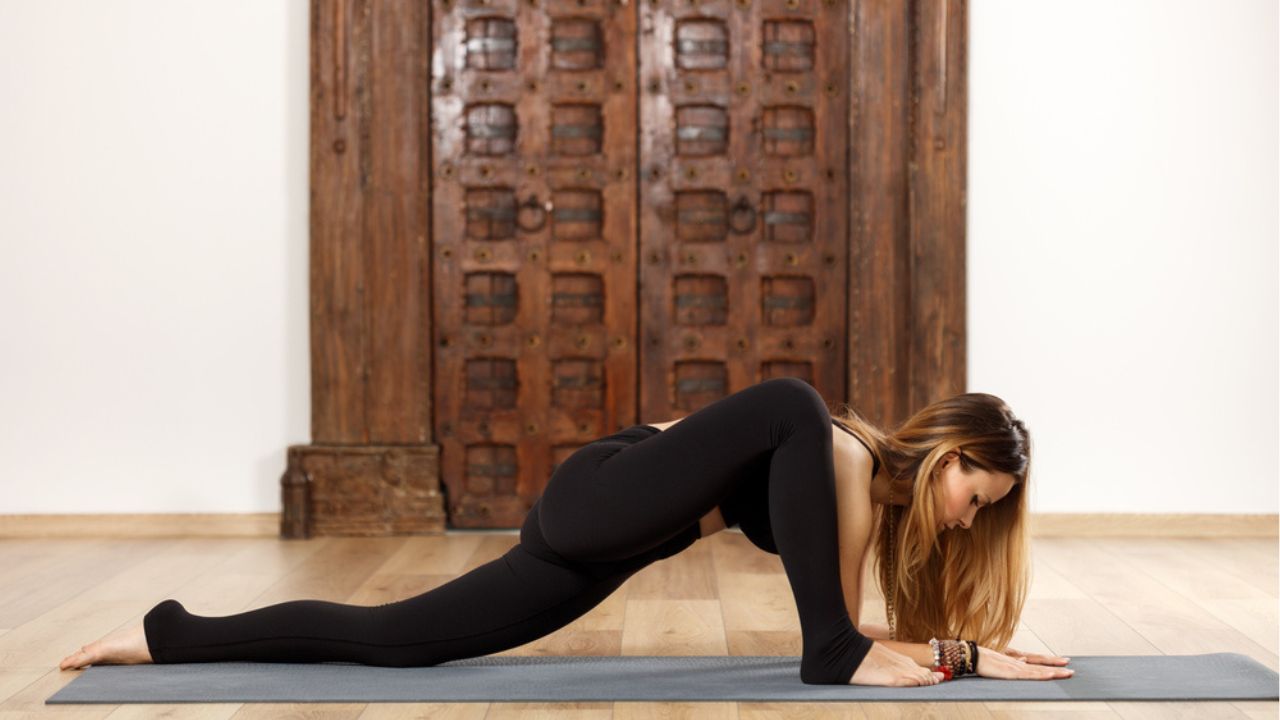
Here's how beginners can ease into the Lizard position with awareness and proper alignment to maximize its benefits while minimizing the risk of injury.
1. As you enter Lizard Pose, you'll notice a deep stretch in the hip flexors of the leg that’s forward. For those starting with the right leg, this will be in the right hip flexors. The opposing inner thigh, your left, should also feel a stretch, signaling that you're in the correct position.
2. While the focus might be on the right leg, your left thigh should not be forgotten. Engage this muscle to support the pose and stabilize your lower body.
3. A slight tightening in your core helps maintain balance and protects your lower back. This engagement is crucial for sustaining the pose without discomfort.
4. Any pain in the lower back is a signal to reassess your form. Flatten your back and engage your core muscles more actively. This adjustment helps in redistributing the stretch and maintaining a neutral spine.
Pay close attention to the sensations your body communicates to you. A stretch should be challenging but never painful. With these tips, beginners can confidently step onto their mats and enjoy the deep, opening benefits of Lizard Pose. Also, if you are new to the world of yoga, it's recommended to get help from yoga instructors and do poses properly.
Safety And Precaution to Consider While Performing Lizard Pose
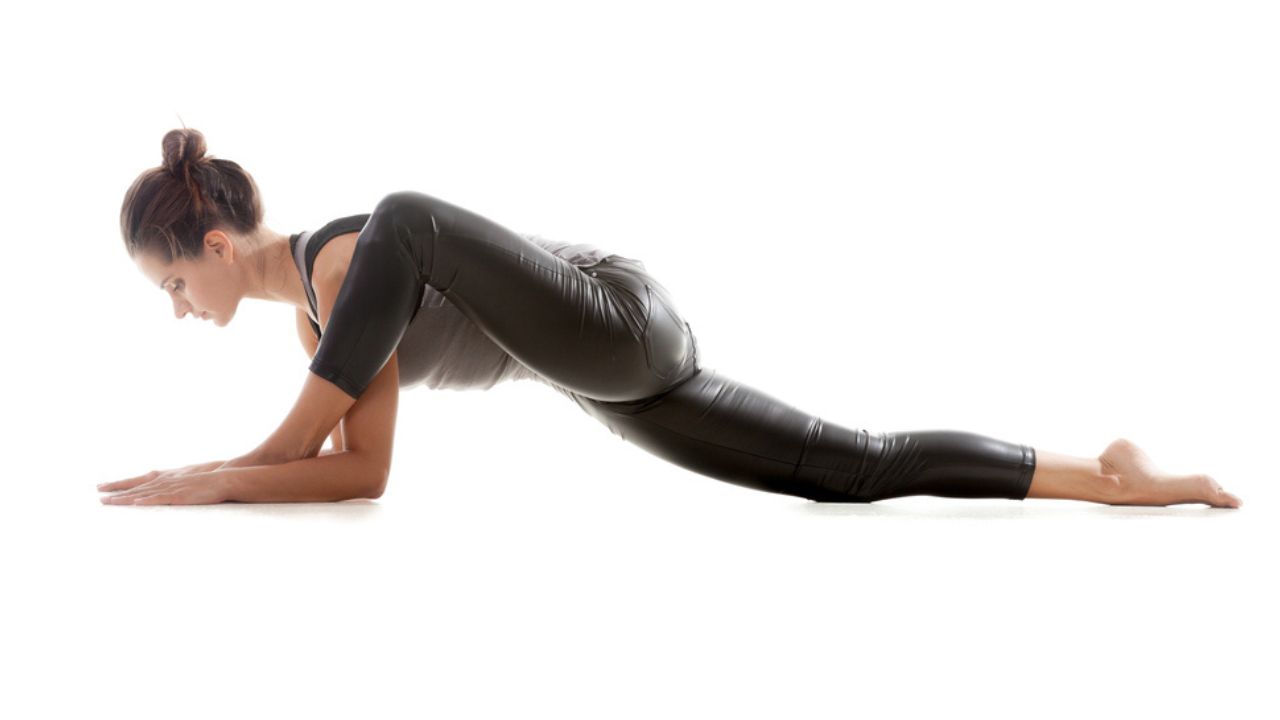
Lizard Pose demands a significant degree of flexibility and strength. Listen to your individual body's signals and recognize when to modify or avoid the pose altogether. Physical discomfort should be a signal to reassess your alignment or to back out of the Lizard Pose Stretch for the day.
Certain health conditions and physical injuries necessitate avoiding Lizard Pose altogether. The deep hip flexion and required stability may exacerbate issues in the following scenarios:
Lower back sensitivity: Individuals with sciatica or chronic lower back pain might find that Lizard Pose aggravates their condition.
Wrist and hand injuries: Given the weight-bearing nature of the pose on the arms, those with wrist or hand injuries should refrain from the practice.
Post-operative recovery: If you're recovering from procedures involving the neck, knees, feet, hips, arms, or hands, Lizard Pose could impede healing.
Shoulder instability: The pose requires solid shoulder engagement; if there's existing instability or weakness, it might lead to strain or injury.
For those with the aforementioned conditions but still wishing to practice yoga, there are always modifications and alternative poses that can provide similar benefits without the risks.
Conclusion
It’s crucial to warm up appropriately, perhaps with a gentle flow through hip circles or a few rounds of Supine Pigeon and Lunges, to prepare for the depths of Lizard Pose. And as you rise from the pose, carry with you the fluidity and openness it imparts. Whether an experienced yogi or a beginner, these insights into Utthan Pristhasana will enrich your practice, bringing a sense of balance and renewal. With each session, you'll find a greater ease in movement and an uplifting of your spirit, reflective of the pose's dynamic nature. Prioritizing your well-being and respecting your body's current state will not only prevent harm but also pave the way for a sustainable and enjoyable yoga journey.
Contributor: Bayu Prihandito, Certified Psychology Consultant, Life Coach, and RYT 200 Yoga Teacher, Founder - Lifearchitekture
ALSO READ: 15 Hip Opening Yoga Poses for Better Mobility And Balance





 JOIN OUR WHATSAPP CHANNEL
JOIN OUR WHATSAPP CHANNEL
































































































